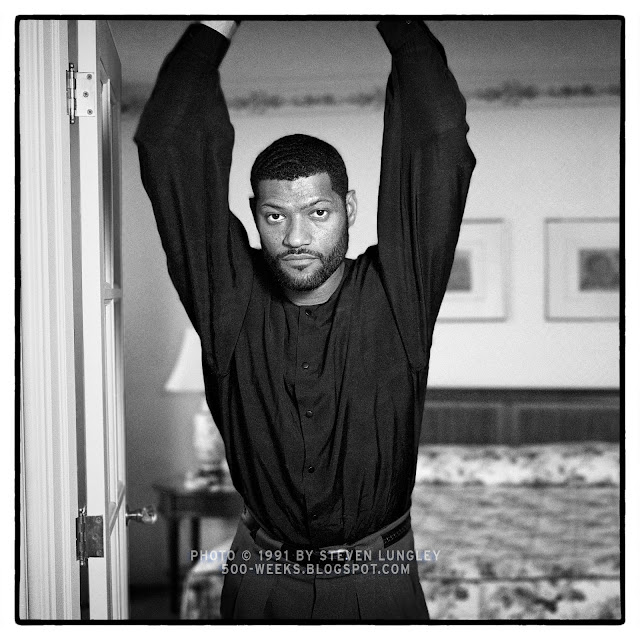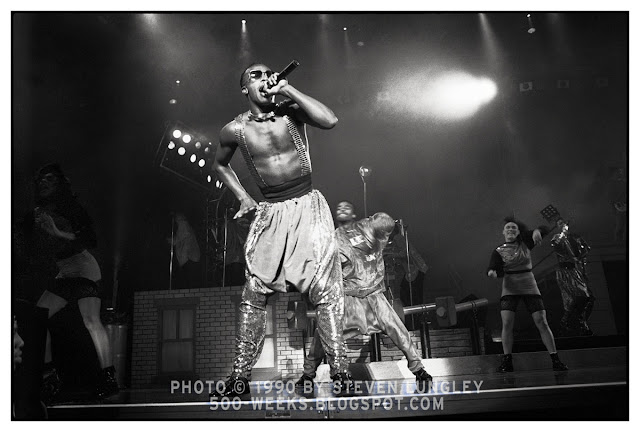Laurence Fishburne and The String Strobe Solution
500 Weeks # 034
 |
| Laurence Fishburne in Toronto, 1991. |
Within a few months of starting to take photos for publications, I realized that I was going to need more than just a camera. If I wanted to make better images, I was going to need some sort of lighting equipment.
I had been working on film crews, and always liked the craft of lighting. However, there was no way I could carry around the huge lights they use to make movies.
Still photographers typically use on camera flash units or off camera studio strobes. The strobes are also flashes, but they output much more light and offer the photographer more ways to control how they light their photographs.
I started searching for some kind of studio strobe that was small, portable and not too expensive. This was before online shopping, so I made a visit to the used department of a large pro camera store in downtown Toronto, which had many units from a manufacturer called Speedotron. I noticed that some of the units were black and some were brown, so I approached the sales associate and asked: “What’s the difference between the black and brown Speedotrons?”
The associate – late middle-aged man with little half-moon reading glasses on a chain – looked over his glasses and down his nose at me as if I had just asked the stupidest question of the century. He held a long pause, before finally responding, pronoucing very slowly and with so much distain that it was dripping, “The Blackline is professional…” He make sure to put extra emphasis on the “Black” in Blackline and the “Fess” in “Pro – FESS- in - alll” to make sure I truly understood how stupid I was.
His uppity attitude struck a couple of thoughts in me:
1) Drop the attitude dude, I’m the one taking photos for publications. You’re working retail.
2) I will never shop in this store.
To this date I have avoided that store whenever I could. They may have been the biggest pro shop in town, but clearly my money wasn’t sufficiently “pro-FESS-in-all” enough for them to be interested in it.
Eventually I landed at a much smaller shop, with a much friendlier attitude. They had a used copy of the smallest, simplest strobe pack made by Speedotron, the Brownline D200. They even helped me understand how to set it up.
I bought it, brought it home and tried to understand how to use it. Problem number one: I did not own a flash meter. I owned a regular light meter, but it only worked with continuous light sources, like daylight. A flash meter is an – expensive - electronic device that is able to measure how bright the burst of light emitted from a flash is in the blink of an eye. That tells the photographer how to adjust their camera settings.
I was able to borrow a flash meter from another photographer though, and forge a workaround: My string strobe solution.
I mounted my one, lowly un-professional Brownline strobe head onto a light stand, positioned with my one small photography umbrella and tied a very long piece of string to the stand. I made knots in the string at 3, 4, 5, 7.5, 10, 12.5 and 15 feet. Using the flash meter, I measured the amount of light coming from the flash and took notes. 100 ISO at all the distances on the string and the same for 400 ISO, double and triple checking the numbers to make sure the results were consistent.
Then I typed my notes up as a small chart that would fit in my wallet and had it laminated. Armed with a chart of my own guide numbers and the string I was ready for bigger assignments.
The studio behind “Boyz n the Hood” were bringing actor Laurence Fishburne to Toronto to promote the film by making him available to the media for brief one-on-one interviews. Share newspaper gave me the assignment to meet, interview and photograph him and to write an article about the movie. The newspaper’s main concern was the written piece, but my biggest interest was the photograph.
This was going to be my first one-on-one with a known performer.
I was ushered into the hotel suite by the publicist and informed that Mr. Fishburne would be along shortly. I looked around, spotted a nice comfy chair and decided that I would conduct the interview as well as stage my photo there. Get out the little Speedotron, set up the gear, stretch out the string, count the knots, check the chart and set the camera.
Then I wait. And start to think. On second thought, the chair is awfully boring. How many photos have I seen of actors in chairs? Many. Too many actually. Also, I don’t like it when people sit for photos. Too much slouching. What could I do differently?
I’m in a suite, and there are double doors leading to the other room. I open them up, step back, take a look and decide – that’s more interesting. More than one layer to the image. The back wall should fall out of focus nicely. I hustle into the other room and open the window blinds to get some daylight coming in to brighten up the background.
Then I have to quickly move my new lighting equipment, check with the string again for the aperture settings and make the necessary adjustments to the camera.
Mr. Fishburne arrives, shakes my hand – firm grip – and this is so long ago he introduces himself with “Hi. I’m Larry” Not Laurence yet, still Larry.
He’s a great photo subject. I place him in the door way and he instinctively knows how to work the surroundings. Like many professional performers, he improvises poses, has an idea of what he wants to project to the lens and does it. Which make me look like a better photographer that I was at that stage of my career. Even as I made the rookie mistake of taking photos while asking questions, resulting in a bunch of frames with his mouth open as he was answering. Talking and portraiture are not a great mix.
So, thank you Mr. Fishburne, you will always be my first celebrity portrait.
I used the sting strobe solution for the next year’s worth of assignments.
Technical stuff: Nikon FE 35mm film camera with Nikkor 35mm, f/2.0 and 50mm f/1.8 lenses, lenses using Kodak T-MAX 400 B&W negative film. Lighting by a lowly, non-pro-FESS-in-al Speedotron Brownline D200, bounced into a small umbrella.




Comments
Post a Comment